by Admin | Jan 27, 2014 | Sports
If you know how to snowboard and would like to teach your kids, or would like to practice with your kids after a lesson, we have some great tips and resources to help you get started.
Parents might wonder what the best age to get kids started; it used to be that age seven was thought to be the best age to start because most kids begin to develop enough core strength and coordination to be able to handle the board. That idea has changed in the last five years with the introduction of new gear and the Riglet Parks by Burton, which have made it possible for kids as young as three to learn. There are still lots of people who think that is too young, and it is best to wait until kids are a bit older, but if you have a child who is eager to learn and you want to teach them, then there is no reason not to.
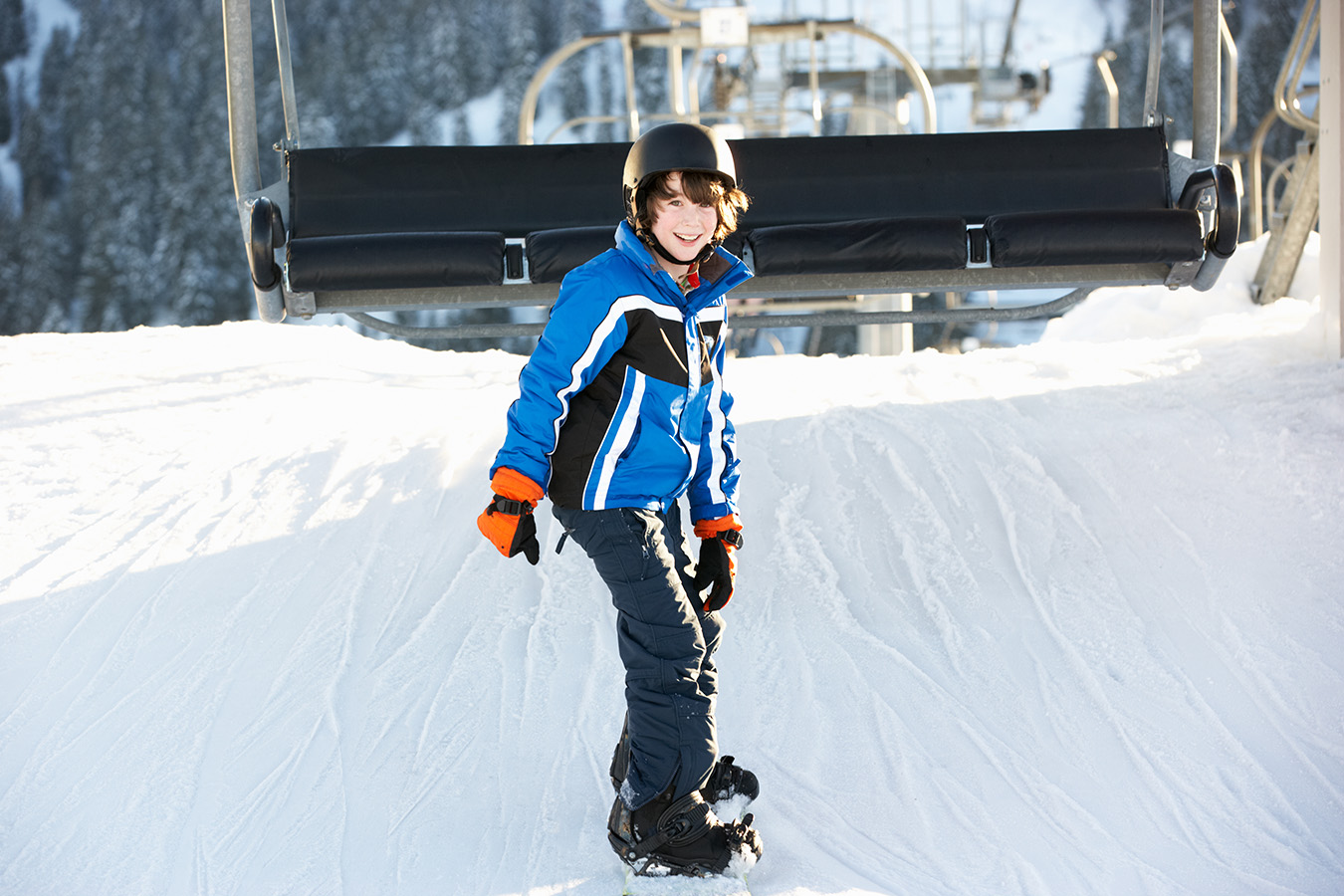
Before you Start
- Make sure your kids want to learn. If they would rather ski, then let them ski. Lots of kids start on skis and then switch over to boarding when they are ready. Just because a three-year-old can do it, doesn’t mean that they are going to want to snowboard. If they don’t want to learn, then it will be challenging to teach them anything, and since the point of boarding is to have fun, if your kid isn’t into it, then leave it for a while and try again another day.
- Get them used to the gear. Before hitting the slopes, you can get them used to what they can expect. If you have bought a board, have them stand on it and show them how to distribute their weight evenly. You can explain to them how they will be using their toes and their heels to change direction and stop. Have your child practice putting on and taking off the board while sitting down. Show the parts of the board, so they will know what you are talking about when you are on the hill.
- Plan on keeping learning sessions short in the beginning. Young kids don’t have the kind of endurance and focus that older kids do. So keep your beginning lessons short, and let your child take breaks as often as they need to. Younger kids will probably only be good for about an hour before needing a break.
Gear for Kids
Before kids can even start, they need to have the right gear. Make sure you have/rent:
- Snowboard – If you are looking for a board for a 3 to 5-year-old, check out these from Burton. They are light, flexible, and have a convex base that makes it easy for a kid to roll from edge to edge and to learn how to stop. You can get these boards as small as 80 cm so kids as young as three can use them. If your kids are very small, you may want to have a look at the Burton Riglet Board Reel that attaches on to the front of the board, so you can tow your toddler along and help get them used to riding and balancing on the board. If you are looking for some other board for small kids, you can try the Flow Micron Mini that also comes in 80 cm length or the Rome Minishred Rocker that you can get as little as 90 cm.
- Boots – There are some great Velcro soft boarding boots around, some of the Velcro Grom boots are available as small as a child’s 11.
- Helmet – Make sure to get a snow sports helmet that will give them protection for the back of their heads as well as allow space for their goggles and will keep their heads warm but allow for ventilation if they get too hot.
- Goggles are essential to help protect kid’s eyes from UVA and UVB sun rays, which are super harsh when reflected off the white snow.
- Gloves or Mittens. Buy gloves that are warm, waterproof, and breathable. You can get special snowboarding gloves that have an outer wrist protector. If you don’t have gloves with a wrist protector, consider using inline skating wrist guards to help protect your kids from getting a broken wrist.
- Warm Clothing. Have your kids dress in clothing that is water-resistant and won’t make kids sweat too much when they get hot. Make sure they are dressed in layers.
Basic Skills for Kids
Whether you are practicing on a small hill, a backyard, local hill, or resort, these are the basics that you are going to want to teach your kids:
Balance – If your kids are very small, an easy way to start is by showing them how to balance on their board. If you have a Riglet Board Reel, you can pull them around with that to help them get used to the feel of the board.
Skate/Glide – Your kids will need to know how to get around on their board, so one of the first things you should teach them is how to skate. With their front foot strapped in, show them how to move the board by using their back foot and pushing using small steps close to the board. Have them do two pushes, then put their back foot right in front of the rear bindings. If you can, attach a stomp pad to the board to make skating and proper foot position easier. Do this on flat terrain and have them do it over and over again until they get it. Snowboard Pro Camp has a good instruction video on how to skate.
Falling and getting up – If your kids are just learning, then they are going to be falling a lot. It’s best to teach them how to fall to avoid injury. Try to get them to fall to the uphill side of the slope and to fall onto their forearms or to make a fist rather than falling onto their hands. Once they are down, show them how to get up by lying on their back and put their feet up towards the sky and rolling over quickly on to their knees. Then get them to stand up from their knees with their hands in front of them.
Stopping and controlling speed – It’s essential that your kids know how to stop. Show them how to turn onto their heel side edge and lift their toes to stop. Greg Anderson has a good video if you would like a visual demo. To further gain some control over the board, show them how to do a heel slide and a toe slide. Snowboard Pro Camp.com has lots of great intro videos, including these on how to do a heel slide and a toe slide.
Turning – Once kids have learned how to toe/heel slide, then they can start to learn how to turn on their board. There are two ways to turn: heel-side and toe-side. When kids are first learning to turn have them practice on a beginner’s slope. Snowboard Pro Camp has another excellent tutorial on how to turn.
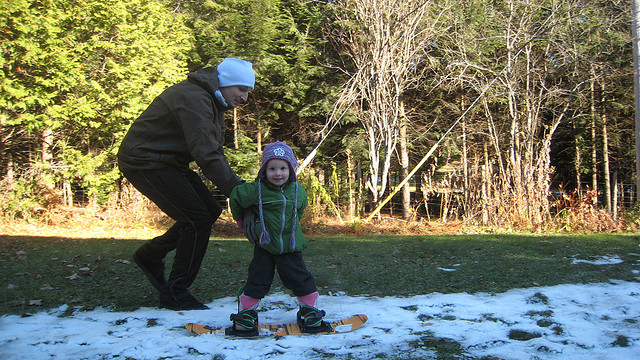
Etiquette Kids Should Know
If you are heading out to a local hill, make sure you go over with your kids some of the basic etiquette.
- The most crucial rule that kids should know is that that skiers and boarder in front of them always have the right-of-way.
- It is also important that they never stop where they can’t be seen by people above them on the hill.
- If they do fall, they should get up quickly to avoid getting run over.
- Before starting down the slope, they should look uphill to make sure no one is coming.
- Before turning, they should check their ‘blind spot’ for other boarders and skiers.
Free Online Lessons for Kids
- The Kellogg Show has an excellent overview of how to approach a lesson with a very small child. Including having the kids go down the hill sitting on the board as though it is a sled, so they can see how fun it is. It also shows how to teach kids to stop and keep them motivated with a hot chocolate reward.
- Snowboards Secret TV follows a nine-year on a simple lesson for a beginner. It gives a useful review of what you should be going over with your kids.
- A former instructor has a good video tutorial on how to teach kids. He goes over tips on gear, skating/gliding, stopping, heel turns, toe turns, c-turns, and s-turns.
Hopefully, you found something that might help you teach your kids to snowboard. If you have any tips for kids, let us know in the comments below.
photo credit: steveyb via photopin cc
by Admin | Jan 20, 2014 | Sports
It’s winter, and for a lot of people, that means one thing: Hockey!
Here in Canada, a lot of kids wind up playing hockey in some form, and why not, kids love playing hockey. They do, however, have to start somewhere. As a wise person once said: The journey of a thousand goals starts with a single puck. (It was me, I said that.)
Whether your kid just plans to play at the local rink with friends, or they want to get into the league system eventually, they need to know the basics. They can take lessons, of course, but even if they do, a little bit of instruction beforehand goes a long way.
Or maybe you want to really get into it, and give them extensive coaching yourself – and why not, it certainly worked for Walter Gretzky. The good news is that you don’t need to be a hockey expert to get your kid started. The amount of videos out there (and other resources) is astounding, and you can get up to speed in no time.
So lace up those teaching skates and keep reading, while we guide you on your journey from the backyard rink to the big leagues.
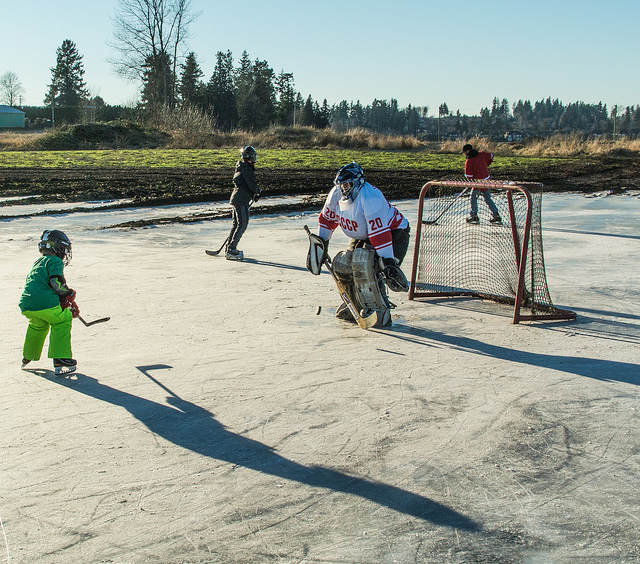
Basic Hockey Skills Parents Can Teach Their Kids
Skating including stopping, turning and skating backward
Obviously, the first skill that your child will need is the ability to skate. The main idea is that they’ll want to (eventually) be able to skate forwards and backward. They’ll also need to learn to stop and turn.
Basic Skating: The first place we’re going to recommend for tips is, of course, our own post on How To Teach Kids Ice Skating. We’ve got some good pointers in there, as well as equipment tips.
Stopping: A great way for kids to stop while skating is the snowplow maneuver. You basically just get them to turn their skates towards each other at the toe and push their heels out. Check out this Youtube video for a good demonstration.
Turning: When learning to skate, kids will instinctively learn to turn by using a two-foot glide and leaning into the direction they want to go. This video gives you some simple instructions on turning, for beginners.
Once they’ve mastered turning, kids should move on to crossover turns. These are more advanced turns where the legs – you guessed it – cross over. When your kid is ready to learn these, check this video out.
Skating Backwards: This is one of the hardest skills to learn for smaller kids, especially when holding a hockey stick. A good video on this would be How to Skate Backwards in Hockey.
Holding the Stick: To avoid bad habits, it’s important that kids hold the stick properly, right from the start. Again we head to Youtube, where former NHL-er Steve Coates demonstrates the correct way method.
Make Sure the Stick is the Correct Height: Hold the stick vertically, with the tip of the blade touching the floor. You want the top of the stick to be at eye level with your child. (That’s if they’re in socks – if they’re in skates, the top of the stick should be where their chin is.)
Puck Control and Stick Handling: Being able to control the puck (also known as Stick Handling) is key to being a decent hockey player. A simple way to work on this is by practicing with a tennis ball. By having a way to do it away from the ice, your kid can get in a lot of quality hours on the road, driveway, or even in the basement. For pointers, we found this training video that has some great stick handling tips.
Passing the Puck: Passing is, of course, an extremely important skill. The best way to learn to pass is visually, and the best video we could find on the subject was this demonstration by Pennsylvania hockey instructor Al MacCormack.
Shooting: There are a few different types of shots in hockey. The best thing for a beginner to learn is the Wrist Shot. We found this very detailed video that should get your kid on the right track.
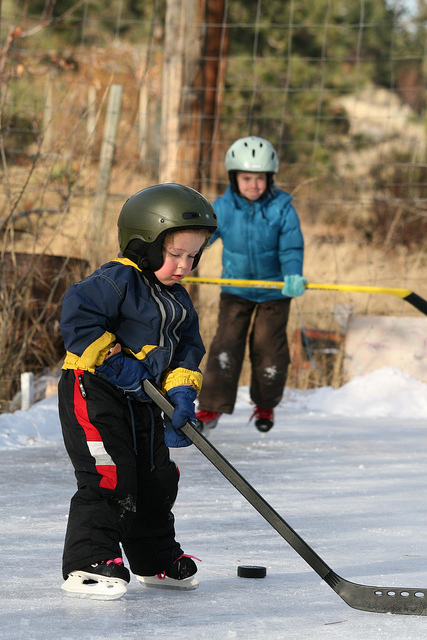
Hockey Books for Kids
If you are looking for more info about hockey for kids, check out these books:
- Kids’ Book Of Hockey: Skills, Strategies, Equipment, and the Rules of the Game by John Sias goes over all the rules of hockey, and everything that your kids need to know if they want to learn how to play. It also has facts, details, and good simple explanations for kids who are learning the game.
- Hockey 123 by Christopher Jordan is a great book for preschool kids, to help introduce them to the main concepts behind hockey. If you like this one, there are a number of books in the series, including Hockey ABC and Hockey Shapes. Kids can count players, sticks, and Stanley cups; explore the colors of the rainbow through team logos and sweaters; look for familiar shapes amongst pucks, scoreboards, and nets, and work their way through an alphabet from Arena to Zamboni.
- Hockey Canada’s Learn All About Hockey: Color and Activity is a hockey workbook where kids can color, follow mazes, do word searches, and more. All details of the game, from the dimensions of the ice surface to the rules, are included. There are images of referee hand signals for penalties, offsides, goals, and more. Players are also introduced to each piece of equipment and taught how it’s used. The book follows two teams as they compete in a hockey game.
- Z is for Zamboni: A Hockey Alphabet by Matt Napier, and Melanie Rose is an alphabet book for very young kids that is all about hockey. It has entries on the rules, players, coaches, teams, and the history of the game. This book would make a great gift.
photo credit: roland via photopin cc
photo credit: JeremyOK via photopin cc
by Admin | Jan 15, 2014 | Sports
If you are looking for a fun, budget-friendly winter sport to do with your children, why not try ice skating?
If you know how to skate yourself then there is no reason that you can’t teach your kids the basic moves such as stopping, starting, falling down, getting up, and gliding that will get them skating on their own in no time.
It might be a little daunting to teach a child yourself, but once they get the hang of it, they will love it, so it is definitely worth a little bit of effort.

Before beginning, you will need to have some equipment. Obviously, you will need skates, and it’s also a good idea to get a helmet. If you would like some extra protection for your children, some people recommend getting knee pads, elbow pads, and wrist guards, although they are not necessary. Kids should also always wear gloves or mittens when skating.
Best Skates for Children
There are lots of options for beginners in terms of types of skates that parents can choose. There are double-bladed, toddler, adjustable, figure, and hockey skates. All the different types have positives and negatives, depending on what type of activity you are planning to do.
If you are a little wary of buying a pair of skates for a rapidly growing toddler, you can try Double Runner Skates. Double runners are basically 2 blades that you strap onto your child’s boots. They are relatively inexpensive and can help toddlers get used to the idea of gliding on the ice. There is some debate as to whether double blades are a good idea or not. People argue that using a double runner doesn’t help beginners learn and you would be better just putting the money towards a pair of regular skates, but they are an option to keep in mind if you don’t want to spend a lot of money and just want to get your toddler out on the ice.
If you would like to go right to regular blades, Bauer Lil Angel or the Bauer Lil Champ are popular choices for children under 5. They are reasonably priced and have enough support for a small child. You can find these products almost anywhere; they are sort of the standard for very young children.
Another good option is boots that are adjustable. They cost a little bit more, but you should be able to get 2-3 years out of them because you can usually adjust the boot part to three different sizes. Lake Placid has some great adjustable models for boys and girls. Although the Lake Placid girls model has a toe pick, which is something that you generally want to avoid when selecting a skate for a beginner. You should avoid picks because they tend to trip up beginners. If you do end up with a pair with a toe pick and your child is having trouble with it, you can have it removed from the same place that you get your skates sharpened.
If your little one is thinking about getting into hockey and you would like to start them off with hockey equipment, you can try the Bauer Vapor X30 Youth Hockey. There are lots of options for beginner hockey skates, but the Bauer model is a good choice for a reasonable price. For older children who just need a pair of decent recreational blades, then have a look at the American Athletic Shoe Girl’s Tricot Lined Ice Skate. This American Athletic model is another great beginner option for the price.
Most of the products we listed fit small, so you may want to consider buying one size up if you end up ordering them online. Before you hit the ice, make sure that the blades have been sharpened, and it is also a good idea to have your kids put on their skates and walk around off ice (if you are at home use an old piece of carpet or large rubber mat) for a while to help them get used to the feel of the boot, you will probably need to hold their hands to keep them stable.
Helmets
Helmets are highly recommended for anyone who is learning. Most recreational rinks (in Canada) will not allow children under 12 to skate without a helmet. Safety experts recommend that they wear a bicycle, skateboard, hockey, or snow sports (ski) helmet. Although there is growing concern from some groups that bike helmets don’t offer enough protection to the back of the head when you fall backward and smack your heads on the ice. A lot of helmets are in the $50 price range, but some rinks offer free helmets to borrow or for a small rental fee. Since sizing for helmets can vary quite a bit, try helmets on before you buy one.
Pointers and Tips to Get Started
Once you are all set up with your equipment, you just need to focus on a few things in the beginning:
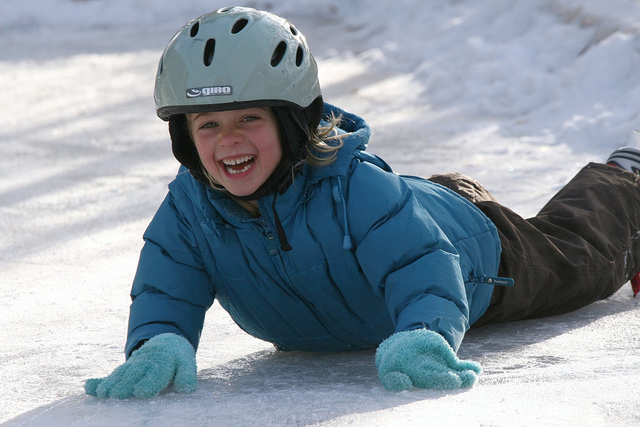
- Start with teaching your child how to fall down and get back up. If your kids are going to skate, they will fall down, so to help get over the fear of falling, have them fall down and get up over and over until they get the hang of it. Try to get your child to fall onto their side, and then they can roll into a crawl position. Then have them kneel on both knees and, while keeping their back straight, bring one skate up onto the ice and push down on that knee. This will help your kids pull themselves up and bring the other skate onto the ice. There is a very good explanation of how to get up here.
- Consider using a teaching aid for the first few attempts at skating. You can use a chair, a 5-gallon paint bucket, pylon, Child Skate Trainer, or milk crate and just have your child push it around the ice. If you are going to a rink, you should check with the rink before bringing any of these aids. They may not allow aids or might have a particular aid that they will rent or let you borrow for a session. If you can find a rink that isn’t crowded, like an outdoor, backyard rink or pond (only if it is safe), it will be much nicer and less stressful for your children to learn.
- To get your kids moving on the ice, have them pick their feet up and down and march to move forward. You are basically just having them sort of walk on the ice as though they are marching. Make sure they keep their knees bent. If you want to go a bit further, check out this video to see a few more things that you can teach to a beginner.
- If your child is feeling a bit unstable, they can bend their knees and put their hand on their knees- this will help stop them from falling. Try to get your kids not to look at their feet, but to look forward in the direction they want to go. They can also hold out their arms in a hug position to themselves balanced. Reminding them to keep their knees bent will help a lot with keeping them upright and stable.
- Keep your skating session short. Your kid’s feet might hurt a bit, and you will want to keep it fun and help encourage them to love skating. If they seem to be losing interest or are getting frustrated, then let them stop and try it again another day.
photo credit: photo credit: JeremyOK via photopin cc






